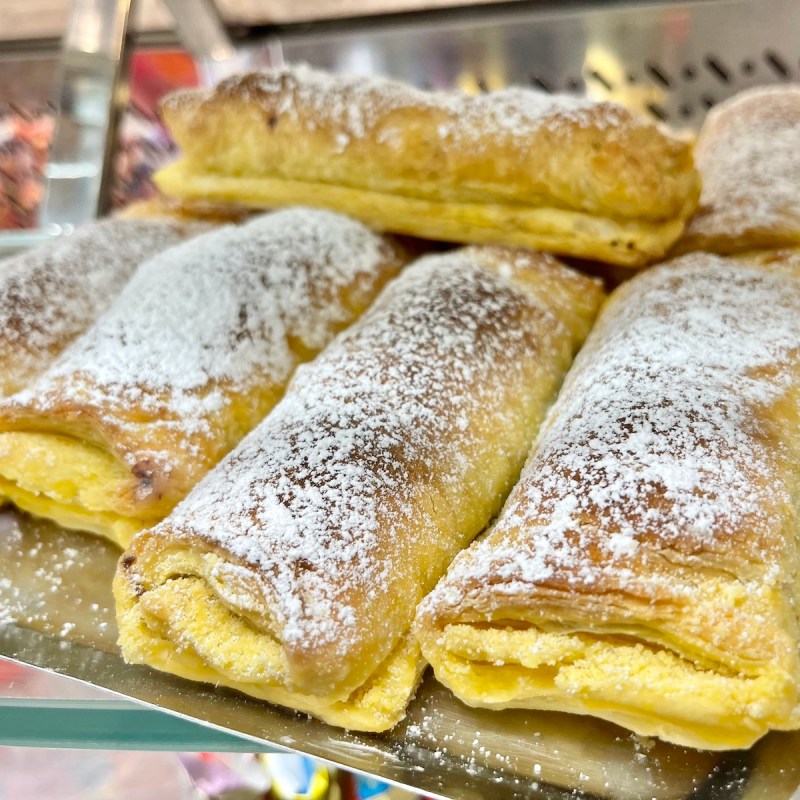
One of our favorite activities on our travels is to visit local bakeries and sample regional pastries. Flakey crusts, interesting fillings, and exotic flavors all make a pastry tasty to us.
Videos by TravelAwaits
Though this is not a definitive list, here are some of Europe’s most delicious pastries. Grab a cup of coffee or tea and let’s get started.

1. Croissant
France
We begin with the croissant, one of the best-known pastries in the world. Whether it actually originated in France is up for debate. What is not debatable is the puffy pastry that has become a legendary French treat.
Perfect for enjoying at a sidewalk cafe or on the run, these buttery, flakey, many-layered pastries abound in France. We love croissants with a slight crunch when you bite into it, followed by little flakes of crust that fly all over you and the table. Stohrer, the oldest patisserie in Paris, serves delicious croissants.

2. Pastel De Belém
Portugal
The original Pastel de Belém can only be found in Lisbon. It was created by the monks of Mosteiro dos Jerónimos. Many churches and monasteries used egg whites to starch religious garments, leaving extra yolks. Putting the yolks to good use, the Pastel de Belém was born. Monks sold the custard pastries to help finance the monastery, but when the monastery closed in 1834, they sold the recipe and Fábrica de Pastéis de Belém opened next to the monastery.
While these are the only tarts directly from the Belém monastic recipe, other versions of the custard tart, known as the pastel de nata, flourish throughout Portugal. They are all delicious and each one is slightly different. We enjoyed doing a “nata crawl” throughout the city to try as many as we could. The bakery in Belém provides small packets of cinnamon and powdered sugar to sprinkle on top. Add a bica (what Lisbon locals call a shot of espresso) and you’ll fit in like a native.
3. Churros
Spain
This is another pastry with an interesting and curious history. Various stories give credit to Portuguese sailors, Spanish shepherds, and the Chinese for their invention. The fried tubes of dough can be thin, knotted, long, spiraled, or straight. The varieties are endless.
But wherever they came from, we think the folks in Spain have perfected them. They traditionally enjoy crispy golden churros dipped into rich chocolate for breakfast. Many corners in Spain and in Portugal have a stand offering this warm, delicious, and satisfying treat.

4. Schneeball
Germany
Although the schneeball is known to come from Rothenburg ob der Tauber in Germany, many German cities now offer this unique pastry. We tried our first schneeball in Heidelberg and look for them whenever we visit Germany.
Once only served on special occasions, schneeballen are now available year round. They consist of shortcrust strips of dough arranged into a ball which is then deep-fried until it turns a golden brown. The original schneeball recipes cover the pastry with powdered sugar. These days creative bakers offer many flavors and toppings, both savory and sweet. When visiting Heidelberg check out Diller Schneeballentraume, for over 20 kinds of schneeballen.
5. Bombolone
Italy
This is not your father’s donut. The bombolone (bomboloni, plural) is believed to have come originally from Austria, which once ruled over parts of Italy. Although a yeast jelly-filled donut, the bombolone is fully round and filled from the top.
Popular in Tuscany, these delightful puffs of joy can be found in other parts of Italy as well. Many bakers use their own approach to textures and fillings and some restaurants provide several fillings from which to choose. Bomboloni fillings can include custard, jam, or cream, so trying several is the best way to appreciate these flavor bombs.

6. Loukoumades
Greece
These sweet little crunchy puffs have a history going back to ancient Greece. Loukoumades or “honey tokens” were given as a reward to winners of the Olympic games. Small dough balls or rings are fried in oil and then dunked in honey or sugar syrup with rosewater.
Bakeries and street vendors throughout Greece offer fresh loukoumades. In Athens, Krinos makes them fresh to enjoy by the plate. They are highly addictive and irresistible, especially when crispy hot and freshly made. Caution: Eating loukoumades will result in very sticky fingers, but it’s well worth it.
7. Cannoli
Italy
The history of the Sicilian cannoli is really fun and as with many other pastries one that can’t really be authenticated. Was it a bawdy fertility symbol created by the harem of a Moorish sultan to please and pay him homage? Or was it created by the nuns of a convent in Caltanissetta? Either way, these crunchy cylindrical tubes filled with ricotta cream cheese (only sheep ricotta for the real cannolo) and decorated with candied fruit, pistachios, or chocolate had stood the test of time.
A visit to Sicily can score the real deal with a “PAT” (prodotto agroalimentare tradizionale) denomination signifying its stature as a traditional agro-food product of Italy.

8. Travesseiros
Portugal
It’s worth the half-hour drive to Sintra from Lisbon just to try the local specialty pastries called travesseiros. The word literally means “pillow” in Portuguese. These delicious little pillows are crispy layers of puff pastry filled with a sweet almond and egg cream and topped with sugar.
They are available in other Portuguese towns, but in Sintra, the locals will tell you that theirs are the original and the best.
One of the best-known spots in Sintra, Casa Piriquita, got the thumbs up from Phil Rosenthal for its delicious travesseiros. The family bakery has been around since 1862. Their travesseiros filling is said to include a secret ingredient, which makes them an even more unique and special treat. As a bonus, the crispy crusted Portuguese cheesecake tarts known as queijadas are another local favorite
9. Baklava
Turkey
We laugh every time we see baklava on a menu. Years ago, we had a very young server tell us they had bak-LAVA (he pronounced it like volcano lava) although it’s actually pronounced BAK-la-va and we’ve been calling it that ever since. Another pastry with mixed heritage, baklava is largely believed to be a Turkish invention that was then spread throughout the Mediterranean by Greek traders. Turkey, Lebanon, Greece, Morocco, and many other countries of the region have a version of baklava.
What makes it so special? Thin phyllo dough layered with butter, nuts, sugar, and spices that is sliced and covered with syrup, which is left to soak into all the layers of phyllo dough. Variations from country to country include the type of nuts (pistachios and walnuts are popular) and the syrup being honey or sugar based, and with or without blossom water. Shapes and sizes can vary as well.
Many places throughout Turkey and Greece serve this traditional pastry. Our advice is to find a small spot favored by the locals, like we did in Turkey — The Old Greek House Restaurant and Hotel just outside Cappadocia. With someone’s grandma doing the baking, that was the best baklava we ever had.

10. Marillenknöedel
Austria
A stroll down any street in Vienna will offer many spots to enjoy an exquisite cake or pastry and coffee. The beauty of the environment along with the delicious bites has made this café culture world famous.
Two of the best-known Austrian delights are the Sacher Torte, a chocolate cake with apricot filling, and Kaiserschmarren, or shredded pancakes. But have you heard of marillenknödel? These dumplings filled with apricot jam and topped with sugar are a very popular local favorite.
As luck would have it, the Wachau region of Austria has the perfect climate to grow sweet and juicy apricots, originally brought there from China. Another global taste connection.

11. Macarons
France
Not to be confused with the tasty macaroon (coconut and almond cookie), the macaron is a quintessential French pastry with, as you might have guessed by now, a mixed history. Was it Arab troops that brought them through Italy and Spain or was it the Carmelite nuns seeking a safe dwelling during the French Revolution who used their baked goods to pay their way?
Perhaps it was the invention of baker Claude Gerber or Pierre Desfontaines of the famous macaron patisserie Lauderée? We may never know. But these delicate, light, two meringue style cookies create a perfect sandwich when filled with jams, chocolate, or buttercream. They’re slightly chewy and it’s hard to eat just one. They’re now available in just about any flavor imaginable. Foie gras? Cheetos? Bloody Mary? We’ve seen them all.
We hope you enjoyed our tour of European pastries as much as we enjoyed tasting them.
Pro Tip: A bakery with a long line is likely a local hot spot. See what everyone is purchasing and buy that. Locals often shop at multiple bakeries for the best items at each.
Many European countries are famous for their cuisine and delight in serving visitors their delightful specialties:
